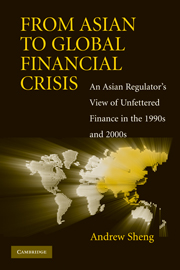 From Asian to Global Financial Crisis
From Asian to Global Financial Crisis Book contents
- Frontmatter
- Contents
- List of Figures
- List of Tables
- Acknowledgements
- Introduction
- 1 Things Fall Apart
- 2 Japan and the Asian Crisis
- 3 The Beam in Our Eyes
- 4 Banking: The Weakest Link
- 5 Washington Consensus and the IMF
- 6 Thailand: The Karma of Globalization
- 7 South Korea: Strong Body, Weak Heart
- 8 Malaysia: The Country That Went Its Own Way
- 9 Indonesia: From Economic to Political Crisis
- 10 Hong Kong: Unusual Times Need Unusual Action
- 11 China: Rise of the Dragon
- 12 From Crisis to Integration
- 13 The New World of Financial Engineering
- 14 What's Wrong with Financial Regulation?
- 15 The Global Financial Meltdown
- 16 A Crisis of Governance
- From Asian to Global Crisis: Chronology of Notable Events
- Abbreviations and Acronyms
- Bibliography
- Index
4 - Banking: The Weakest Link
Published online by Cambridge University Press: 05 June 2012
- Frontmatter
- Contents
- List of Figures
- List of Tables
- Acknowledgements
- Introduction
- 1 Things Fall Apart
- 2 Japan and the Asian Crisis
- 3 The Beam in Our Eyes
- 4 Banking: The Weakest Link
- 5 Washington Consensus and the IMF
- 6 Thailand: The Karma of Globalization
- 7 South Korea: Strong Body, Weak Heart
- 8 Malaysia: The Country That Went Its Own Way
- 9 Indonesia: From Economic to Political Crisis
- 10 Hong Kong: Unusual Times Need Unusual Action
- 11 China: Rise of the Dragon
- 12 From Crisis to Integration
- 13 The New World of Financial Engineering
- 14 What's Wrong with Financial Regulation?
- 15 The Global Financial Meltdown
- 16 A Crisis of Governance
- From Asian to Global Crisis: Chronology of Notable Events
- Abbreviations and Acronyms
- Bibliography
- Index
Summary
One thing is certain, that at particular times a great of deal of stupid people have a great deal of stupid money. … At intervals, from causes which are not to the present purpose, the money of these people – the blind capital, as we call it, of the country – is particularly large and craving; it seeks for someone to devour it, and there is a ‘plethora’; it finds someone, and there is ‘speculation’; it is devoured, and there is ‘panic’.
~ Walter Bagehot, Essay on Edward GibbonWas the Asian crisis a classic currency crisis or was it a banking crisis? Currency crises are about flight of capital, both domestic and foreign, and they arise because central banks do not have enough foreign currency to defend their national exchange rate. Nobel Laureate Paul Krugman was amongst the first to question the validity of the Asian Miracle by asserting that Asian growth was more a product of perspiration than inspiration. In January 1998 he was also amongst the first to point out that any analysis of the Asian crisis ‘needs to focus on two issues normally neglected in currency crisis analysis: the role of financial intermediaries (and of the moral hazard associated with such intermediaries when they are poorly regulated), and the prices of real assets such as capital and land’. In other words, the Asian crisis was a banking crisis on top of the currency crisis, where asset bubbles and moral hazard played important roles.
- Type
- Chapter
- Information
- From Asian to Global Financial CrisisAn Asian Regulator's View of Unfettered Finance in the 1990s and 2000s, pp. 86 - 108Publisher: Cambridge University PressPrint publication year: 2009


